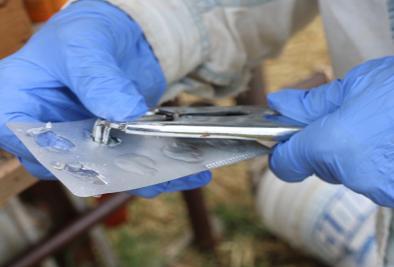
Adaptation and development of the anesthetic elastrator band for use in the Canadian lamb industry
Research team
Drs. Brenda Ralston, Merle Olson, Denis Nagel and their research teams
Collaborators
• Alberta Veterinary Laboratories Ltd., Calgary, AB)
• Chinook Contract Research, Airdrie, AB
• Lakeland College
Funders
• RDAR
• Alberta Lamb Producers
Summary
A new product has been developed to add to livestock producers’ toolboxes for pain mitigation. The LidoBand™ is like the regular castration/tail docking elastration band currently available to livestock producers with the addition of lidocaine to control pain. Developed by Chinook Contract Research (CCR) and Alberta Veterinary Laboratories (AVL), the LidoBands™ are being tested for licensing in Canada. Currently if producers want to use these bands for their animals, a veterinary prescription is required. Talk to your vet about the use of Lidobands™ .
Background

Canadian livestock producers are continuously seeking ways to mitigate pain for their animals. CCR and AVL have developed a novel way to deliver lidocaine topically via elastration bands to mitigate pain immediately during the castration procedure and through the following days until the tail and/or scrotum has cast. Lidocaine is a local anesthetic that works to prevent pain signals from beginning or being transmitted by blocking the sodium channels in the affected area.

Methodology
This study evaluated release levels of lidocaine into scrotal neck tissues and tail tissues following the application of LidoBands™ at acute time points (0.5, 1, 2, 24, and 72 hours) and chronic time points (14, 21, 28, and 35 days). To correlate an animal’s reaction to peripheral variable nerve stimulation with scrotal tissue lidocaine concentration. To correlate cortisol and substance p levels in treated animals at baseline (time 0) and 24, 72, 14, 21, 28 and 35 days to a control group.

Results
Blood samples were taken from the study lambs at specific time points and tested for cortisol and substance p which are indicators of the body’s stress response. Cortisol is a stress hormone that signals prolonged, systemic stress. Substance p is a neuropeptide the indicates acute, localized stress and pain experience. Cortisol levels tended to be lower in LidoBand™ banded animals at each time point relative to baseline (pre-banding), almost reaching statistical significance at 72 hours. Substance p levels tended to be lower in LidoBand™ banded animals at each time point relative to baseline (pre-banding), reaching statistical significance at 35 days.
To get an indication of pain at the site of the bands, an electrode was used to induce nerve activity. The LidoBand™ readings yielded significantly lower stimulation scores by onehour post-banding in tails, and by two hours in scrotums.
In another study by the same team, they found that the tissue concentrations of injectable lidocaine yielded a 95 per cent reduction in local sensation for 120 to 180 min following the injection; however, additional strategies are needed to manage long-term pain. Using the LidoBand™ provided tissue lidocaine concentrations that met or exceeded the 95 per cent reduction for at least 21 to 28 days and, based on electrostimulation data, provided local anesthesia for at least three days when compared to a control band.
There were no adverse events or device failures (i.e. band breakage or failure to castrate/ tail-dock) observed during this study.

Why it matters
Livestock producers want to do the right thing to ensure their animals experience as little pain as possible. Happy, healthy animals equate to productive ones. Having another tool in the toolbox to mitigate pain is beneficial to the industry and provides producers with more management options.
Currently LidoBands™ are not available where producers buy other elastrator rings, but they can be purchased through their veterinarian.


